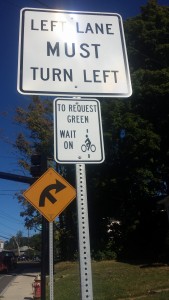WESTFIELD—Although it’s clear that Westfield officials want to continue to improve the city’s streets, the mode of getting there isn’t quite as pristine.
City council is expected to continue discussing the Complete Streets initiative in a couple of weeks and city officials are diverging on how they feel about the program. Currently, the city council is waiting to vote on a Complete Streets ordinance that would adopt the state program into the municipality. While some view the program as intrusive upon the city and limiting to construction and development efforts and others see it as a step in the right direction toward improving Westfield’s existing infrastructure, there are more who aren’t even sure what the program is.
The Complete Streets initiative is part of a nationwide coalition that claims to provide safer and more economically-friendly roadways, while also providing healthier ways of travel. This could be through bike lanes or other pedestrian-friendly raised crosswalks, bus-friendly access points or by creating traffic calming measures to reduce speed and congestion.
Massachusetts adopted their Complete Streets initiative in 2006, and was one of the first states to do so. As of 2014, 27 total states are part of the program.
Massachusetts, like the other states, promote the program by providing partial funding for road repair and construction programs that fit into the Complete Streets requirements, with Massachusetts providing money to municipalities on a percentage basis, barring that the municipality accepts and adopts a Complete Streets initiative of their own.
“The legislation put in funding for $50 million a year for two years statewide,” Mark Cressotti, Westfield city engineer, said. “It’s based on chapter 90 funding rules, so you would receive approximately 25 percent of your [chapter 90 funding] total.”
The Complete Streets Program from MassDOT says that up to a total of $450,000 is available for applicable municipalities, but according to Cressotti’s calculations Westfield would be eligible for about $300,000 from the program.
This amount may not seem like much, especially considering that the city’s budget is over $130 million, but Cressotti said that any money that is added to the city for projects is a good thing, no matter how small. Plus, the commitment could promote more spending for improvements that Westfield needs.
“We already spend the money and so we may as well get money back,” Cressotti said.
Of course, if the ordinance is adopted it could mean higher spending for the city, which has seen seven consecutive years of raised taxes until this fiscal year.
And this is one reason why opponents are so concerned.
“As more communities might look at accepting the Complete Streets funding there will be less funding available, which worries me,” ward 4 city councilor Mary O’Connell said about the program. “What we have been told is we can apply for a $200,000 grant to do grant design work, but we can only do that twice in a year. I don’t ever want to turn down money but the price is too high.”
O’Connell and others worry that if the ordinance is accepted, then road projects will increase in cost due to the additional needs of the program. And although Cressotti agrees that construction costs may increase, it will be offset by the potential increase in revenue that may be seen in certain areas, like what Cressotti claimed occurred in the downtown Westfield area—Ebenezer’s Bar and Grille and Alternative Furniture notwithstanding, who have closed or will be closing within the next six months. Also, Cressotti said that the construction would help to continue Westfield’s growing appeal.
“You have to make improvements to maintain standards,” Cressotti said.
O’Connell though, feels that it is not just money that the city would lose due to adopting the ordinance and program.
“I’m not against cleaner, reduced fuel, reduced carbon footprint but I have a problem with Complete Streets because I feel it is too much for our community to give up for what we’re getting in return,” she said. “We are giving up autonomy for this—the state wants to take control of design plans for future projects through the program.”
O’Connell said that this could leave Westfield bearing the financial burden, when funding is expected to dry up in 2017. The funding could be passed again or raised of course, but it could also be dissolved or lessened, too.
Her example of this from the state is the Quinn bill, a piece of legislation passed by Bay State legislators in 1970 which required municipalities to pay additional money to police officers who had or earned higher education while serving their departments. Although the state dropped funding of the program in 2012, many communities like Westfield are still paying officers for the program following contract negotiations, and it is estimated to be costing millions to city budgets, for better or for worse.
Also, O’Connell feels that the ordinance would infiltrate the city’s many boards and departments through various concessions.
“There is a comment in the program to appoint one member in every committee, one person who supports complete streets,” O’Connell said. “It also says we agree to incorporate this into every publicly and privately funded project, if appropriate.”
To Cressotti though, the key phrase is “if appropriate.”
Cressotti said that the Complete Streets ordinance only applies to areas where it would make sense for it to be implemented. Cressotti said that as an example, if a road is a low-traveled two-lane way he is not going to put in bicycle lanes or sidewalks, because they are not appropriate.
“Engineers must consider Complete Streets for every project but do not need to implement it necessarily,” he said.
So for now, regardless of if the ordinance passes, know that if you live on a lonely, two-lane road, you’re probably not getting a sidewalk anytime soon.




